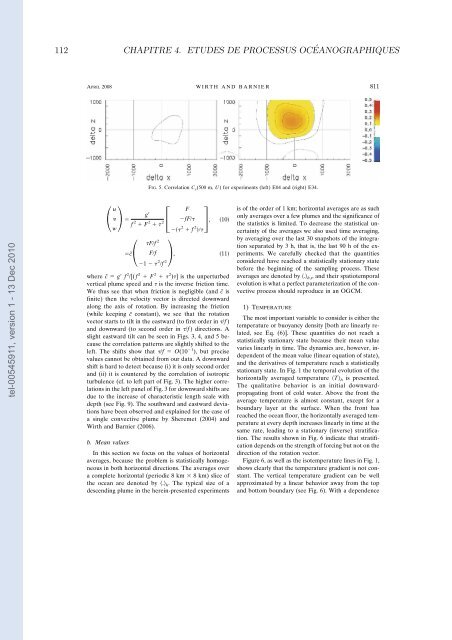Etudes et évaluation de processus océaniques par des hiérarchies ...
Etudes et évaluation de processus océaniques par des hiérarchies ...
Etudes et évaluation de processus océaniques par des hiérarchies ...
Create successful ePaper yourself
Turn your PDF publications into a flip-book with our unique Google optimized e-Paper software.
112 CHAPITRE 4. ETUDES DE PROCESSUS OCÉANOGRAPHIQUES<br />
APRIL 2008 W I R T H A N D B A R N I E R 811<br />
FIG. 5. Correlation C y (500 m, U) for experiments (left) E04 and (right) E34.<br />
tel-00545911, version 1 - 13 Dec 2010<br />
u <br />
w 2<br />
F<br />
<br />
g<br />
fF<br />
f 2 F 2 <br />
2 f 2<br />
c˜ Ff 2<br />
2 Ff ,<br />
1 2 f<br />
,<br />
10<br />
11<br />
where c˜ g f 2 /[(f 2 F 2 2 )] is the unperturbed<br />
vertical plume speed and is the inverse friction time.<br />
We thus see that when friction is negligible (and c˜ is<br />
finite) then the velocity vector is directed downward<br />
along the axis of rotation. By increasing the friction<br />
(while keeping c˜ constant), we see that the rotation<br />
vector starts to tilt in the eastward (to first or<strong>de</strong>r in /f )<br />
and downward (to second or<strong>de</strong>r in /f ) directions. A<br />
slight eastward tilt can be seen in Figs. 3, 4, and 5 because<br />
the correlation patterns are slightly shifted to the<br />
left. The shifts show that /f O(10 1 ), but precise<br />
values cannot be obtained from our data. A downward<br />
shift is hard to d<strong>et</strong>ect because (i) it is only second or<strong>de</strong>r<br />
and (ii) it is countered by the correlation of isotropic<br />
turbulence (cf. to left <strong>par</strong>t of Fig. 3). The higher correlations<br />
in the left panel of Fig. 3 for downward shifts are<br />
due to the increase of characteristic length scale with<br />
<strong>de</strong>pth (see Fig. 9). The southward and eastward <strong>de</strong>viations<br />
have been observed and explained for the case of<br />
a single convective plume by Sherem<strong>et</strong> (2004) and<br />
Wirth and Barnier (2006).<br />
b. Mean values<br />
In this section we focus on the values of horizontal<br />
averages, because the problem is statistically homogeneous<br />
in both horizontal directions. The averages over<br />
a compl<strong>et</strong>e horizontal (periodic 8 km 8 km) slice of<br />
the ocean are <strong>de</strong>noted by . h . The typical size of a<br />
<strong>de</strong>scending plume in the herein-presented experiments<br />
is of the or<strong>de</strong>r of 1 km; horizontal averages are as such<br />
only averages over a few plumes and the significance of<br />
the statistics is limited. To <strong>de</strong>crease the statistical uncertainty<br />
of the averages we also used time averaging,<br />
by averaging over the last 30 snapshots of the integration<br />
se<strong>par</strong>ated by 3 h, that is, the last 90 h of the experiments.<br />
We carefully checked that the quantities<br />
consi<strong>de</strong>red have reached a statistically stationary state<br />
before the beginning of the sampling process. These<br />
averages are <strong>de</strong>noted by . h,t , and their spatiotemporal<br />
evolution is what a perfect <strong>par</strong>am<strong>et</strong>erization of the convective<br />
process should reproduce in an OGCM.<br />
1) TEMPERATURE<br />
The most important variable to consi<strong>de</strong>r is either the<br />
temperature or buoyancy <strong>de</strong>nsity [both are linearly related,<br />
see Eq. (6)]. These quantities do not reach a<br />
statistically stationary state because their mean value<br />
varies linearly in time. The dynamics are, however, in<strong>de</strong>pen<strong>de</strong>nt<br />
of the mean value (linear equation of state),<br />
and the <strong>de</strong>rivatives of temperature reach a statistically<br />
stationary state. In Fig. 1 the temporal evolution of the<br />
horizontally averaged temperature T h is presented.<br />
The qualitative behavior is an initial downwardpropagating<br />
front of cold water. Above the front the<br />
average temperature is almost constant, except for a<br />
boundary layer at the surface. When the front has<br />
reached the ocean floor, the horizontally averaged temperature<br />
at every <strong>de</strong>pth increases linearly in time at the<br />
same rate, leading to a stationary (inverse) stratification.<br />
The results shown in Fig. 6 indicate that stratification<br />
<strong>de</strong>pends on the strength of forcing but not on the<br />
direction of the rotation vector.<br />
Figure 6, as well as the isotemperature lines in Fig. 1,<br />
shows clearly that the temperature gradient is not constant.<br />
The vertical temperature gradient can be well<br />
approximated by a linear behavior away from the top<br />
and bottom boundary (see Fig. 6). With a <strong>de</strong>pen<strong>de</strong>nce
















